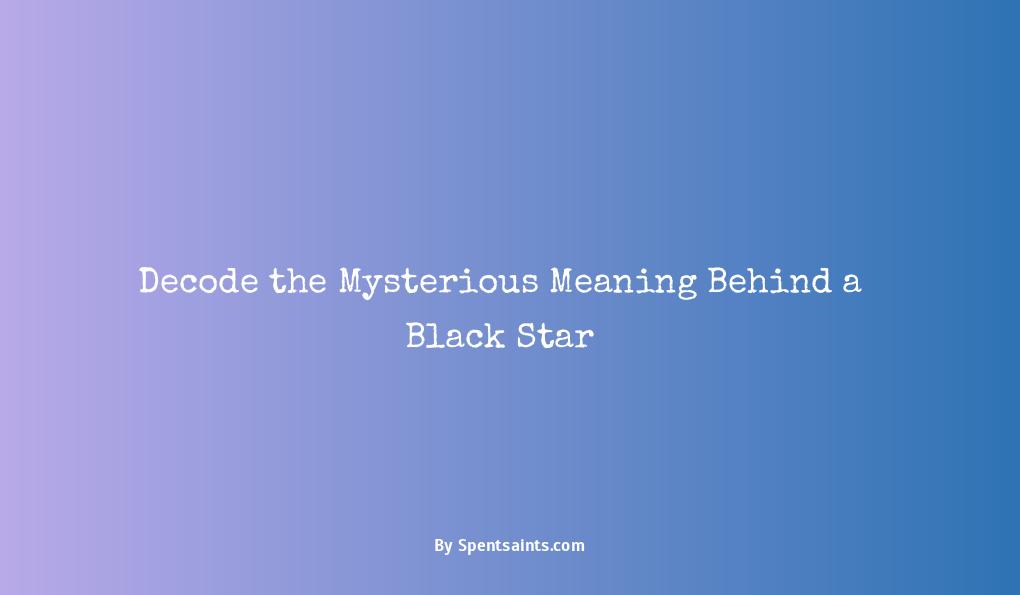The black star is one of the most cryptic and esoteric symbols, conjuring images of the occult, divination, and magic. But where does this mysterious symbol come from and what meaning has it held throughout history?
Tracing the heritage of the black star reveals a winding path across cultures and eras, populated by sorcerers, deities, astronomers and more. By decoding this enigmatic sign, much can be revealed about humanity’s eternal search for meaning in a mystifying universe.
The Black Star Origins in Ancient Beliefs and Religions
Black star symbolism has its roots in humanity’s oldest spiritual traditions. Nearly every ancient culture studied the night sky, discerning patterns and symbols among the stars. Constellations took on sacred stories and characters, while dark voids and nebulae provoked fearful superstition.
To the Babylonians, Sumerians, and Assyrians, the black star embodied chaos and creation. In some myths, it marked the primordial stuff from which the gods crafted the heavens and earth. Dark nebulae like those in Orion were considered the chaotic abyss, out of which order emerged.
Deities and Demons Associated with the Black Star
Various mythological figures were linked to the black star and its chthonic symbolism. The Mesopotamian goddess Ishtar, who represented fertility and war, was associated with the iconic eight-pointed star symbol. In Egypt, Osiris ruled as god of death and rebirth. The black sarcophagus with white stars that held his corpse and facilitated his resurrection evokes the image of the black star.
Mesoamerican cultures like the Aztec and Maya also attached underworld gods to the black star. Tezcatlipoca, god of night and sorcery, bears a black star symbol on his chest, representing primordial chaos. Other death gods like Mictlantecuhtli and Xolotl wore black star markings as well.
Alchemists and Occultists Charge the Black Star
By medieval times, the black star meaning became intertwined with Western occultism and alchemy. The eight-pointed Seal of Solomon, a hybrid pagan-Judaic mystical symbol, was commonly represented as a black star. Alchemists like Paracelsus explored its connections to prima materia, the formless base of all matter.
In the Victorian era, the Hermetic Order of the Golden Dawn incorporated the black star into occultist symbolism representing duality and the shadow aspect of nature. Aleister Crowley also adopted the black star, which remains important in modern magical and Wiccan traditions.
The Black Star in Astronomy and Science
Apart from supernatural interpretations, the black star fascinates rational investigation as well. In astronomy, black star refers to a theoretical dying star that has cooled to the point of no longer emitting light. Black dwarf stars, black holes, and dark nebulae demonstrate this scientific meaning of black star.
Black Holes Devour Light in Space
Black holes bend spacetime so extremely that nothing can escape, including light itself, lending profound mystery. Supermassive black holes like Sagittarius A* anchor the centers of most galaxies. Smaller stellar black holes also wander through space, leaving faint traces as they consume dust and gas.
NASA’s future IXPE satellite uses X-ray polarimetry to better understand flattened jets of energy and particles that whip around black holes. Learning more about these bizarre dynamos where the known laws of physics collapse helps unveil the mysteries of cosmic forces.
Dark Nebulae: Stellar Nurseries Wrapped in Shadow
Dark nebulae are enormous clouds of gas and space dust that block light. These cocoons and pillars provide ideal shelters for baby stars to grow. The Eagle Nebula’s iconic towers house newly forming stars and protoplanetary disks.
Infrared telescopes like the retired Spitzer Space Telescope peer through dark nebulae’s concealing dust. New stellar cocoons get discovered frequently, indicating a healthy rate of star birth.
The Allure of the Black Star in Pop Culture
Beyond supernatural mysticism and astronomy, the black star retains cultural power in fiction, music, design, and more. Science fiction, in particular, utilizes black hole and dark matter concepts metaphorically.
Black Star in Comic Books and Sci-Fi
In DC comics, the imprisoned Anti-Monitor overwhelms and converts the hero Black Racer into a “Black Lantern,” resurrecting the dead into a zombie army wielding black power rings. The Black Star character Darkstar controls the ebony Darkforce Dimension.
The Black Sun in Star Wars channels “unseen mass” from another dimension, powering superweapons like the Death Star’s planet-killing cannon. Bad Robot’s TV series Fringe explores a tears in reality called Zero Event Black Holes. The black star’s scientific mystery and vast destructive potential make it a flexible science fiction trope.
Blackstar as a Pop Culture Persona
Musicians like Elvis, Yngwie Malmsteen, Anvil, Arcturus and more adopted “Blackstar” as recording names and album titles. Fashion icon David Bowie created a enigmatic persona Ziggy Stardust as an alien rock star savior. His swan song album Blackstar released 2 days before he died of cancer, its meaning puzzled over by critics and fans alike.
The black star’s aura of otherworldliness continues to infuse mythic qualities into modern pop culture. Deciphering the secrets that still swirl around this unknowable sign remains an alluring quest.
Despite profound insights from religion, science, and art, a shroud of mystery enfolds the black star across every field. The knowledge that so much remains undiscovered in cosmic dark matter and deep space keeps this symbol cloaked in an aura of alien vastness and unlimited potential.
By escaping the bounds of earthly existence and finite timescales, the black star eludes absolute definitions. It emerges as a conceptual wormhole to fathomless dimensions of imagination and spirit. In the end, the black star may reflect humanity’s eternal journey to make sense of the sublime and endless mystery housed in the heavens.

Dreams, spirit, growth – I explore them all. Laugh, learn, grow with me. Unlock your inner guru.
